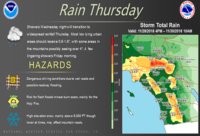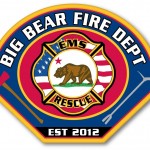
 Big Bear, CA – The California Department of Transportation is alerting the traveling public that a significant winter storm will arrive in the Inland/Mountain/Desert communities of Riverside and
Big Bear, CA – The California Department of Transportation is alerting the traveling public that a significant winter storm will arrive in the Inland/Mountain/Desert communities of Riverside and
San Bernardino counties Wednesday evening. The National Weather Service is forecasting rain and snow during the storm events. Caltrans is advising motorists of winter driving tips and some possible impacts during the storms.
Snow is predicted in mountain regions of at least four inches beginning in higher elevations dropping down to the 5,000-foot level as the storm progresses. Chains will be required in mountain areas. Remember to bring chains even if it not snowing so you don’t get caught without them during sudden weather changes.
Mud and debris flows are always possible during heavy rain events. The recent burn area of the Valley Fire, SR 38 through Forest Falls/Mountain Home Village, is an area of concern. Evacuations and road closures may be possible due to the threat of debris flows. Desert regions are also subject to debris flows and road closures. Mountain areas typically experience increased rock fall during and after storm events.
Urban freeways and routes are subject to flooding during heavy downpours or extended periods of rain. Never try to drive through debris flows, large puddles or standing water. Do not drive past “Road Closed” signs and always follow commands and instructions from Caltrans personnel, CHP/law enforcement and emergency responders. Substances that build up on roadways such as oil and other vehicle fluids, can lead to slippery roads and the loss of tire friction. These substances mixed with water create a greasy layer that becomes slippery and can cause vehicles to hydroplane, which means you will slide on the roadway without control of the vehicle. Below are some helpful safety tips:
– First, before you drive, check travel conditions, road closures and chain controls at
http://quickmap.dot.ca.gov/.
– Check your tires and wipers. Make sure they are in good condition. Have a full tank of gas.
– Slow down when driving in adverse weather conditions! Reduce your speed when roadways are icy
or wet or your sight distance is affected. – Avoid travel during heavy rain or snow events.
– Leave at least three car lengths between you and the vehicle in front of you.
– Turn on your lights – the law says your lights must be on when windshield wipers are on.
– Try and stay in the center lanes – puddles typically form on the shoulder and median. Try to drive in the tracks of the vehicle in front of you at a safe distance.
– Do not use cruise control.
– Avoid sudden acceleration and braking. Do not make sudden turns or lane changes and slow down and be more cautious when driving on curvy roads due to traction, ice and standing water.
– Bring a charged cell phone and charger, food, water, medications, flashlight, warm clothing/blankets and appropriate footwear in case you become stranded.



